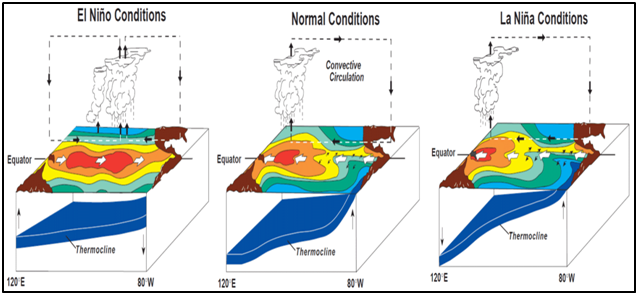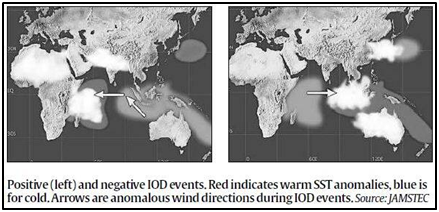Why in News?
- With the El Nino phenomenon almost certain to affect the Indian monsoon this year, high hopes are pinned on the development of a positive Indian Ocean Dipole (IOD) and its ability to counterbalance the El Nino effect.
What’s in Today’s Article?
- About ENSO (El Nino, La Nina, Impact, etc.)
- About IOD (Positive/Negative IOD, Impact on Southwest Monsoon)
What is ENSO (El Nino and Southern Oscillation)?

- ENSO is one of the most important climate phenomena on earth due to its ability to change the global atmospheric circulation, which in turn, influences temperature and precipitation across the globe.
- Though ENSO is a single climate phenomenon, it has three states, or phases, it can be in:
- El Nino:
- A warming of the ocean surface, or above-average sea surface temperatures (SST), in the central and eastern tropical Pacific Ocean.
- It is associated with lower than normal monsoon rainfall in India.
- La Nina:
- A cooling of the ocean surface, or below-average SSTs, in the central and eastern tropical Pacific Ocean.
- It is associated with a comparatively better monsoon rainfall in India.
- Neutral:
- Neither El Nino nor La Nina.
- Often tropical Pacific SSTs are generally close to average.
What is Indian Ocean Dipole (IOD)?

- The Indian Ocean Dipole (IOD) is defined by the difference in sea surface temperature between two areas (or poles, hence a dipole) – a western pole in the Arabian Sea (western Indian Ocean) and an eastern pole in the eastern Indian Ocean south of Indonesia.
- In scientific terms, the IOD is a coupled ocean and atmosphere phenomenon, similar to ENSO but in the equatorial Indian Ocean.
- A ‘positive IOD’ — or simply ‘IOD’ — is associated with cooler than normal sea-surface temperatures in the eastern equatorial Indian Ocean and warmer than normal sea-surface temperatures in the western tropical Indian Ocean.
- The opposite phenomenon is called a ‘negative IOD’, and is characterised by warmer than normal SSTs in the eastern equatorial Indian Ocean and cooler than normal SSTs in the western tropical Indian Ocean.
- The IOD was identified as an independent system only in 1999.
Does IOD Impact Southwest Monsoon?
- There is no established correlation between Indian summer monsoon rainfall and IOD.
- However, studies have shown that a positive IOD year sees more than normal rainfall over central India.
News Summary:
- With the El Nino phenomenon almost certain to affect the Indian monsoon this year, high hopes are pinned on the development of a positive Indian Ocean Dipole (IOD) and its ability to counterbalance the El Nino effect.
- A positive IOD has the potential to offset the impacts of El Nino to a small measure in neighbouring areas.
- It has, at least once in the past (1997), delivered admirably on this potential.
- While the El Nino is already firmly established in the Pacific Ocean this year, the IOD is still in the neutral phase.
- All international climate models suggest a positive IOD event may develop in the coming months.
- The India Meteorological Department (IMD), in its bulletin earlier this month, said there was an 80% chance of a positive IOD in the coming months.









